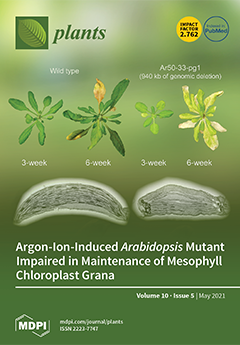To better understand the source–sink flow and its relationships with zinc (Zn) and other nutrients in wheat (
Triticum aestivum L.) plants for biofortification and improving grain nutritional quality, the effects of reducing the photoassimilate source (through the flag leaf removal and spike
[...] Read more.
To better understand the source–sink flow and its relationships with zinc (Zn) and other nutrients in wheat (
Triticum aestivum L.) plants for biofortification and improving grain nutritional quality, the effects of reducing the photoassimilate source (through the flag leaf removal and spike shading) or sink (through the removal of all spikelets from one side of the spike, i.e., 50% spikelets removal) in the field of the accumulation of Zn and other nutrients in grains of two wheat cultivars (Jimai 22 and Jimai 44) were investigated at two soil Zn application levels. The kernel number per spike (KNPS), single panicle weight (SPW), thousand kernel weight (TKW), total grain weight (TGW) sampled, concentrations and yields of various nutrient elements including Zn, iron (Fe), manganese (Mn), copper (Cu), nitrogen (N), phosphorus (P), potassium (K), calcium (Ca) and magnesium (Mg), phytate phosphorus (phytate-P), phytic acid (PA) and phytohormones (ABA: abscisic acid, and the ethylene precursor ACC: 1-aminocylopropane-1-carboxylic acid), and carbon/N ratios were determined. Soil Zn application significantly increased the concentrations of grain Zn, N and K. Cultivars showing higher grain yields had lower grain protein and micronutrient nutritional quality. SPW, KNPS, TKW (with the exception of TKW in the removal of half of the spikelets), TGW, and nutrient yields in wheat grains were most severely reduced by half spikelet removal, secondly by spike shading, and slightly by flag leaf removal. Grain concentrations of Zn, N and Mg consistently showed negative correlations with SPW, KNPS and TGW, but positive correlations with TKW. There were general positive correlations among grain concentrations of Zn, Fe, Mn, Cu, N and Mg, and the bioavailability of Zn and Fe (estimated by molar ratios of PA/Zn, PA/Fe, PA × Ca/Zn, or PA × Ca/Fe). Although Zn and Fe concentrations were increased and Ca was decreased in treatments of half spikelet removal and spike shading, the treatments simultaneously increased PA and limited the increase in bioavailability of Zn and Fe. In general, different nutrient elements interact with each other and are affected to different degrees by source–sink manipulation. Elevated endogenous ABA levels and ABA/ACC ratios were associated with increased TKW and grain-filling of Zn, Mn, Ca and Mg, and inhibited K in wheat grains. However, the effects of ACC were diametrically opposite. These results provide a basis for wheat grain biofortification to alleviate human malnutrition.
Full article






